Decomposition is vital to all ecosystems, both in the ocean and on land. Decomposers eliminate water contaminants, making the other animals healthier. Decomposers break down dead and decaying matter, releasing nutrients that producers need. Most decomposers are low on the food chain, but the animals on the upper end rely on the decomposers. Bacteria and fungi are the primary decomposers in the ocean. Here we’ll take a closer look and them and four others.
1) Bacteria

An aquarium is experiencing a bacterial bloom.
©iStock.com/ComR78
In the ocean, microorganisms like bacteria are the primary decomposers. In the coldest ocean waters, bacteria and fungi are the only decomposers surviving extreme temperatures and conditions. Bacteria convert the decomposing material into simpler compounds like carbon monoxide and simple sugars.
These single-cell microorganisms break down animal waste. They are a part of the circle of life and complete the food chain.
2) Fungi

This is a brown mushroom on a coral reef.
©Pataporn Kuanui/Shutterstock.com
Fungi are important decomposers in the ocean. There are 2.21 million types of eukaryotic microbes in ocean waters worldwide. The marine fungi are divided into microfungi, yeasts, or swimming zoospores. Fungi are microscopic; however, they play an enormous role in cleaning ocean waters for other life forms.
3) Sea Worms (Annelida)

Sea worms are also called marine worms.
©Sandiwild/Shutterstock.com
Several sea worms play a role as decomposers in the ocean. There are 17,000 types of seaworms. Seaworms are commonly called segmented worms or marine worms.
Christmas Tree Sea Worm (Spirobranchus giganteus)
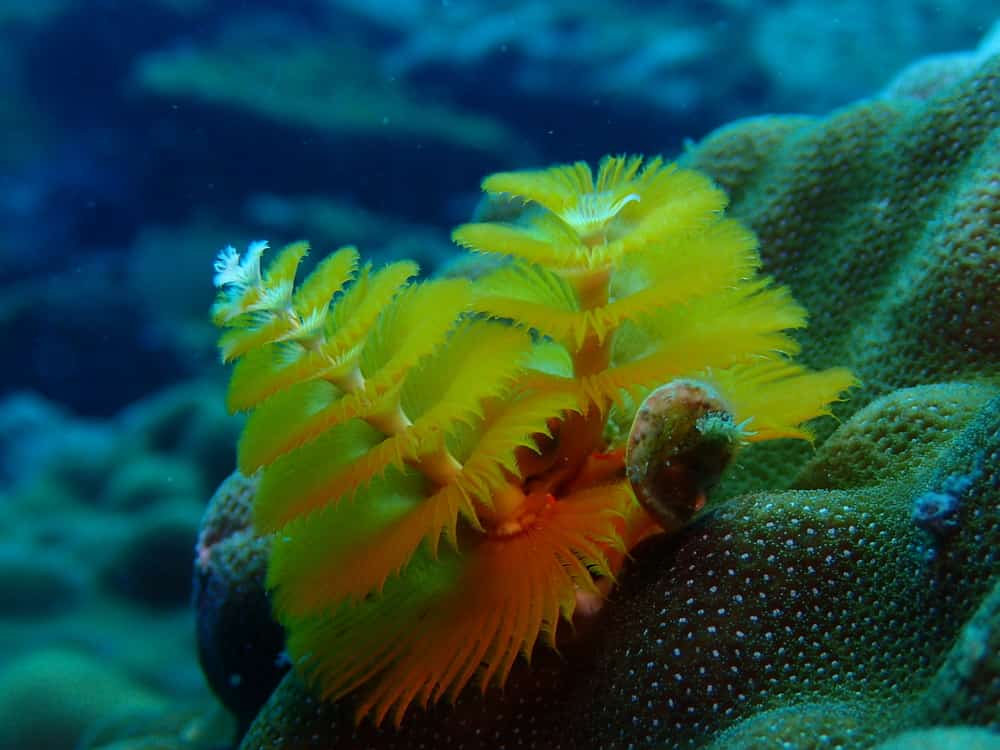
Christmas tree worms are filter feeders that live on tropical coral reefs.
©Beau_G/Shutterstock.com
The bristles on the Christmas tree worms are used for feeding and substitute as gills. They grow to be 1.5 inches long. Christmas tree worms live on tropical coral reefs. Christmas tree worms eat zooplankton, phytoplankton, and detritus particles.
The worms are omnivorous filter feeders. When their plumes are visible, two-thirds of the worm is anchored into the coral reef. Christmas tree worms live for up to 30 years. Unlike their relative the fireworm, the Christmas tree worm is not harmful to humans.
Feather Duster Sea Worm (Sabellidae)
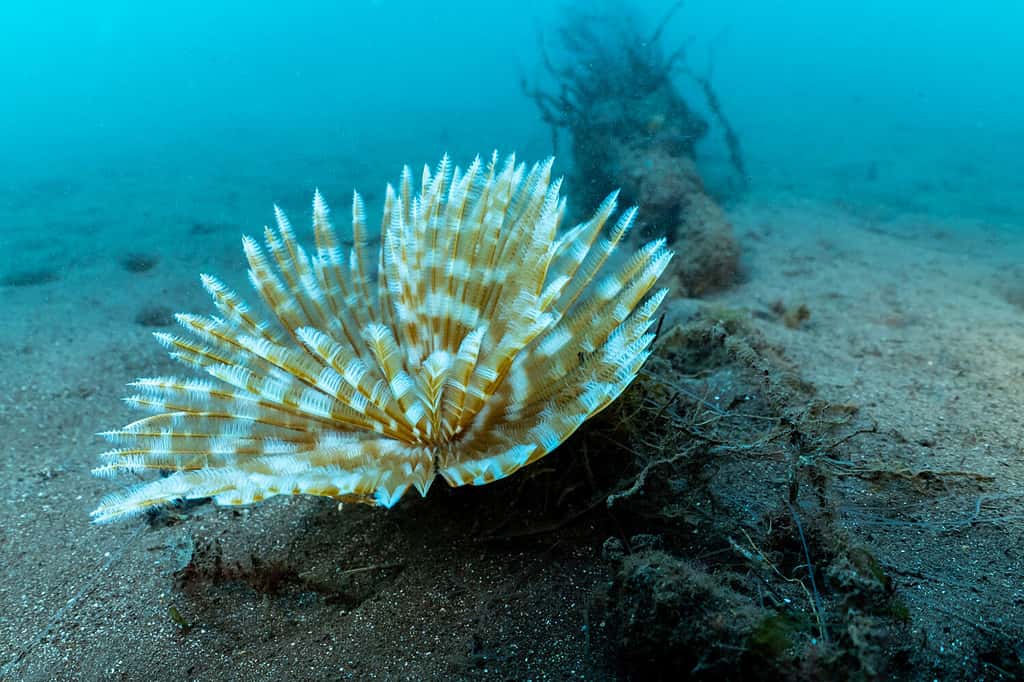
is the scientific name for the feather duster worm.
©Silent O/Shutterstock.com
Sabellidae are sedentary worms. They create tubes out of a bodily secretion combined with bits of sand and shell. Their bodies are soft and vulnerable. However, the tube provides them protection. They range in colors from white and pink to purple and bright yellow.
Feather duster worms live along rocky shores and on coral reefs. They are found on man-made pillars. The worms live in ocean waters worldwide.
Fire Worm (Hermodice carunculata)
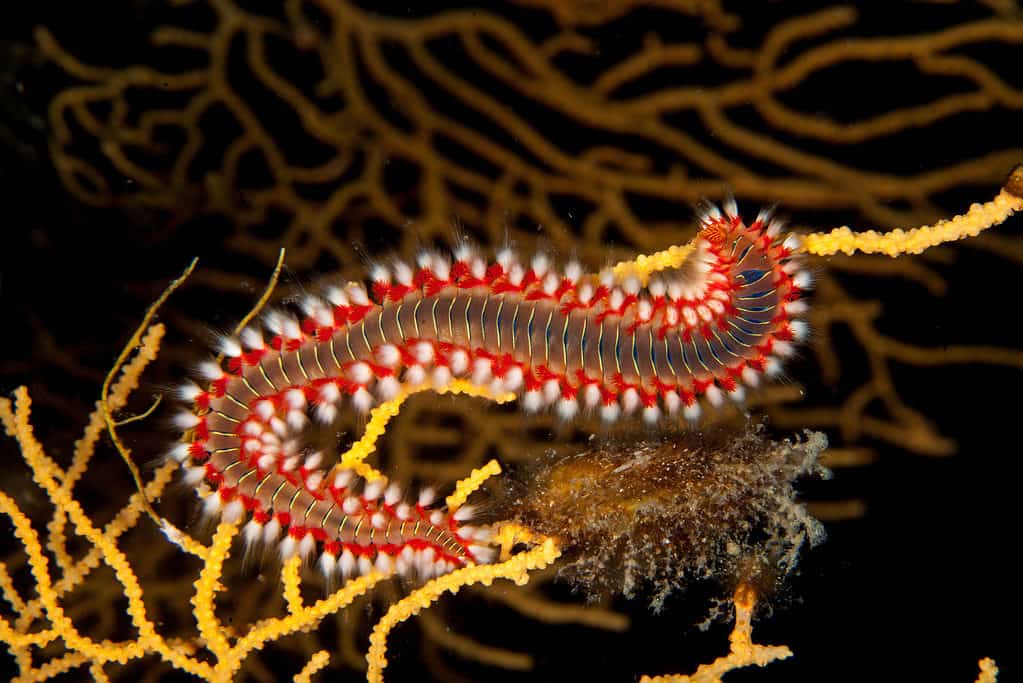
The bearded fireworm is venomous.
©Gerald Robert Fischer/Shutterstock.com
The fireworm lives throughout the mid-Atlantic and the tropical western Atlantic. Fireworms eat coral, small crustaceans, and anemones and grow as long as a human forearm. The worms produce special luciferase enzymes in their genes that make them glow.
The spiny protruberances along the body of the fireworm contain venom. Contact with the spines will make humans nauseated, dizzy, and sick. Sandtile fish and white grunts feed on fireworms.
4) Echinoderms (Echinodermata)
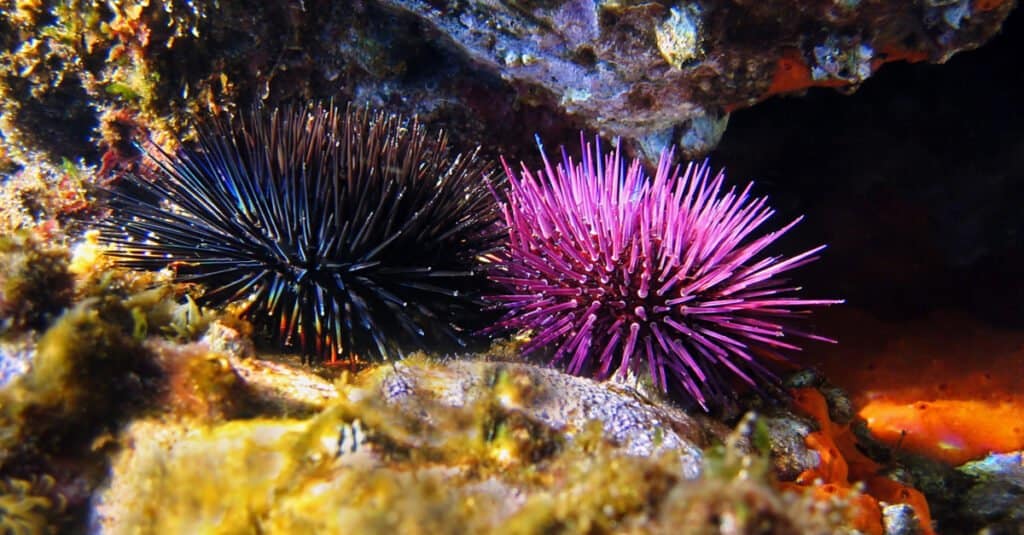
Sea urchins use their spiked shells to protect themselves from predators.
©Damsea/Shutterstock.com
The echinoderms are decomposers in the ocean that include sea cucumbers and sea urchins. These animals serve an important service to marine life. Echinoderms have no brains, and they have no hearts. Some echinoderms are asexual and some have sexes assigned.
Sea Cucumbers (Holothuroidea)
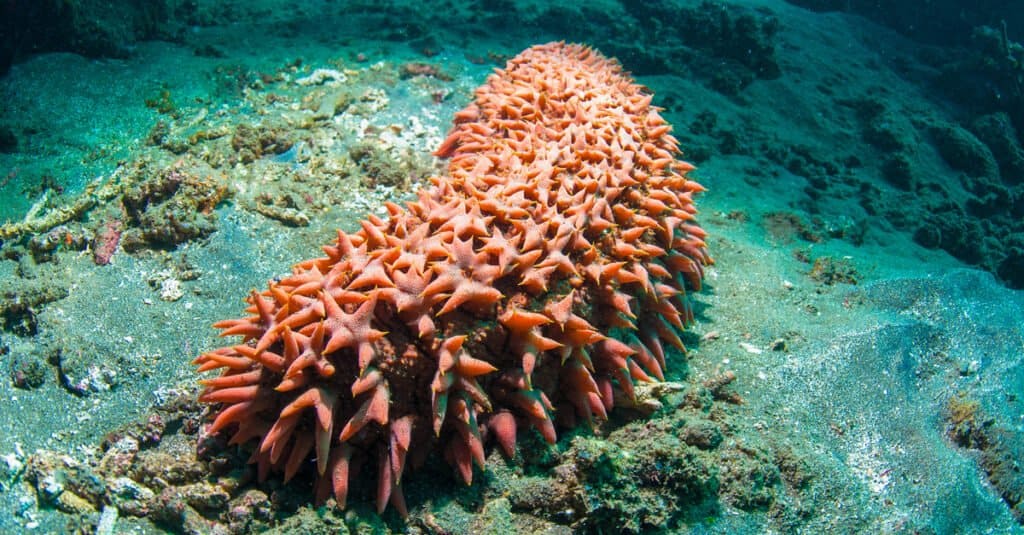
A sea cucumber has ten tentacles around its mouth.
©e2dan/Shutterstock.com
The sea cucumber feeds on algae, aquatic invertebrates, and waste particles in the benthic zone. The benthic zone is the sea floor. Sea cucumbers have ten tentacles around their mouth.
Female sea cucumbers lay eggs by releasing them into the water. The eggs come into contact with sperm in the water and are externally fertilized.
Sea Urchins (Echinoidea)
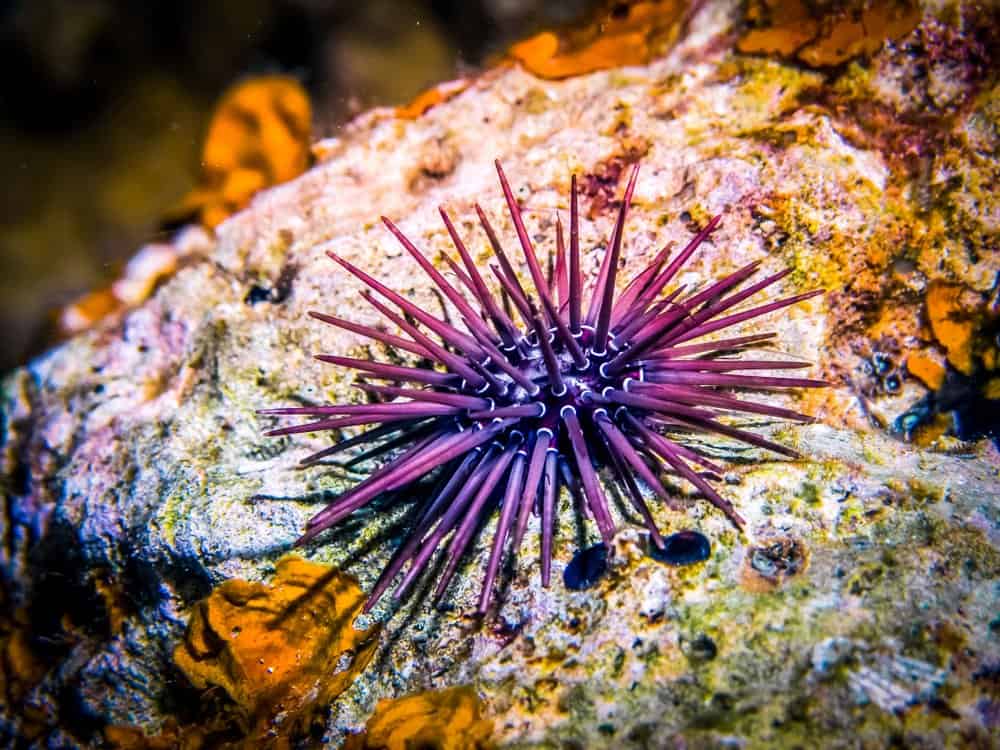
The
sea urchin
does not have a brain.
©HotFlash/Shutterstock.com
The sea urchin scrapes algae from the ocean floor, among other things. However, these animals do not have a brain. There are 950 species of sea urchins. These unique creatures have chewing organs called Aristotle’s lanterns with complex jaws and five self-sharpening teeth.
Sea urchins eat the algae they find, plankton, kelp, periwinkles, and sometimes even barnacles and mussels that they grind up with their self-sharpening teeth. Although they live in the ocean, they do not swim. Sea urchins move along the ocean floor by crawling.
Like the sea cucumber, the sea urchin is male and female, and they release sperm and eggs into the water. The eggs are fertilized when they come into contact with the sperm. Sea urchins are both consumers and producers.
5) Crustaceans (Crustacea)
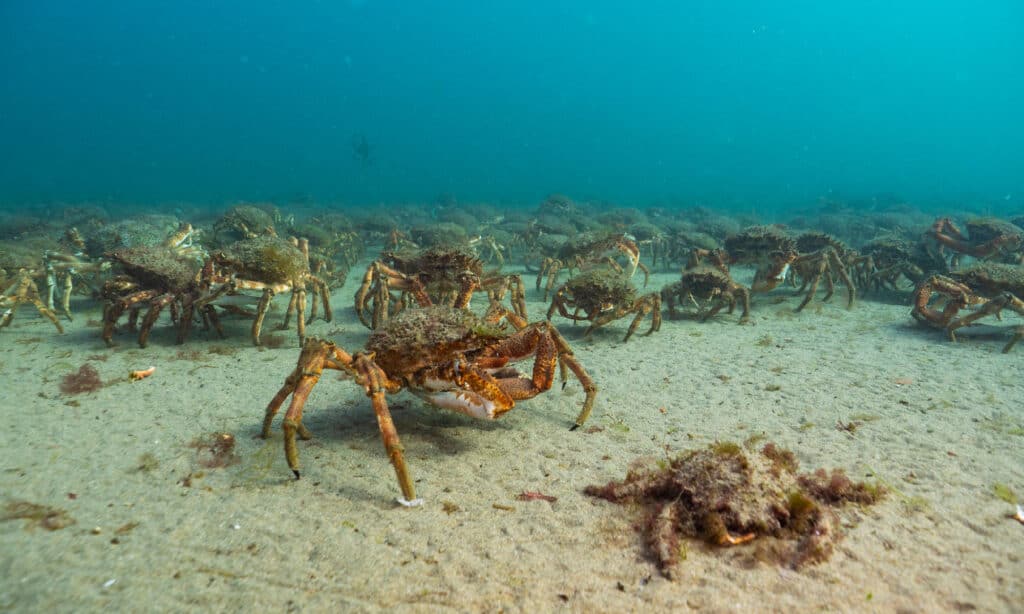
Crabs on the ocean floor are the garbage disposals of the ocean.
©iStock.com/Jake Davies
Crustaceans are essential decomposers in the ocean. Crustaceans are opportunistic feeders that eat small fish, other crustaceans, algae, dead animals, and other things in the ocean. They are the garbage disposals of the ocean.
Crabs (Brachyura)
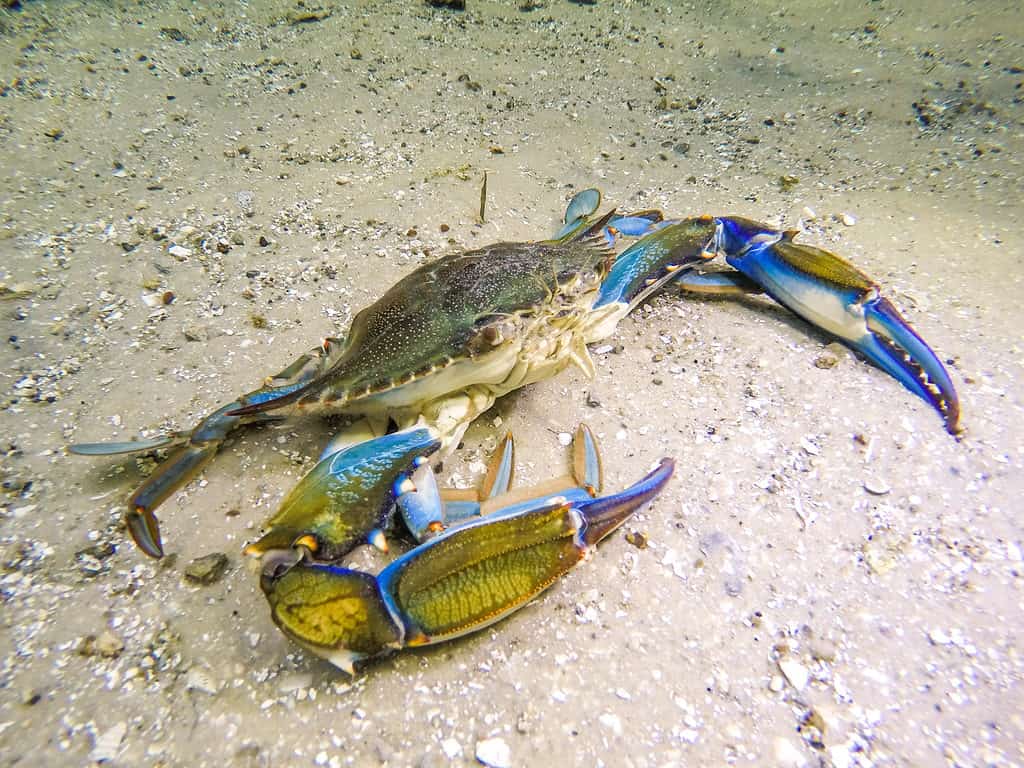
Blue crabs catch food with their pinschers, then tear and eat it in sections.
©Jen Helton/Shutterstock.com
All crabs are decomposers in the ocean. However, blue crabs are the most common variety of crabs found along the Atlantic Coast. Blue crabs live for about three years. They become mature at 12 to 18 months. Having ten legs makes the crabs decapod. Walking sideways is their favorite way to move. However, they can walk in any direction and swim.
The blue crab reaches five inches by the time it reaches maturity. Size limits established by fish and game authorities establish that blue crabs under five inches are illegal to keep. This regulation protects the juvenile crabs.
Crabs eat food they find on the ocean floor and food they find floating or swimming in the water. They aggressively attack their food by clamping their pinschers onto it and tearing off sections.
Woodlice (Armadillidium vulgare)
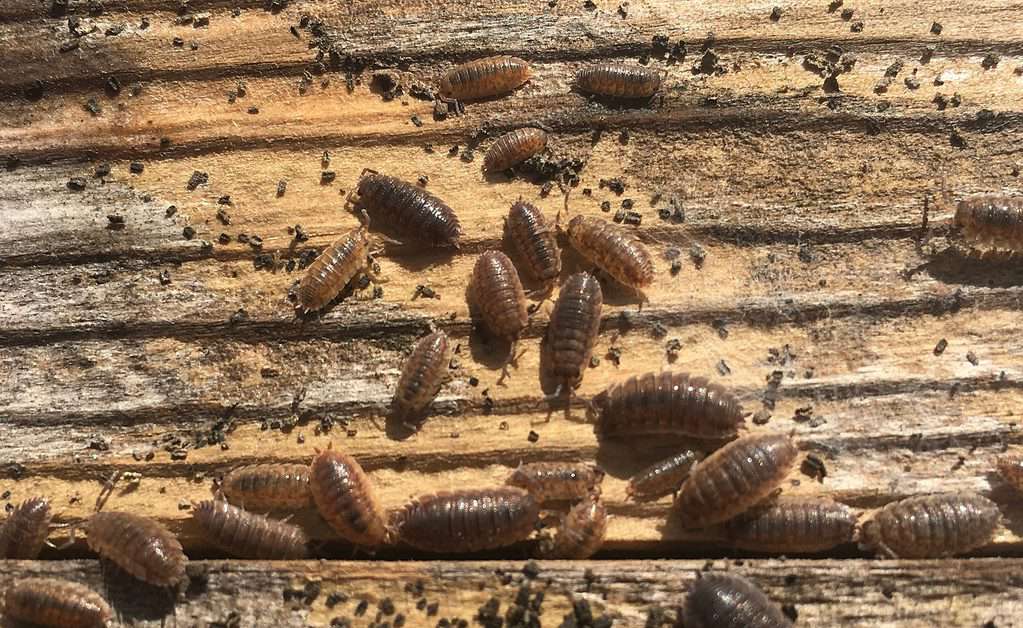
Woodlice eat decaying wood and do no damage to living plants or animals.
©Ellianne/Shutterstock.com
The woodlice are decomposers in the ocean that primarily feed on rotten wood. They have 14 legs, with two on each of their seven body segments. The most common woodlice in ocean waters is the sea slater (Ligia oceanic). Woodlice eat decaying wood and do no damage to living plants or animals.
Woodlosue are either pill woodlice that can roll into balls for protection or slater woodlice. Slater woodlice are amphibious and pill woodlice are not.
6) Mollusks (Mollusca)

Mussels feed on decaying organic materials, plankton, and bacteria.
©Vyacheslav Saltayev/Shutterstock.com
Mollusca are an essential group of decomposers in the ocean. These animals are invertebrates. Instead of a mouth, they have a radula, which is like the tongue, except it is rough and has tiny teeth. The Mollusca have no brain, but many have two hearts.
Clams (Bivalvia)

Clams are bivalve mollusks.
©Gabe Dubois/Shutterstock.com
These mollusca do not have a radula. They are filter feeders. When water is filtered into the clam, it comes into contact with a sticky mucus substance like glue. The food and particulates stick to the mucus. They eat plankton, algae, and other organic matter and clean up the water while they feed.
Lobsters (Nephropidae)

Homarus gammarus is the scientific name for the American lobster.
©RLS Photo/Shutterstock.com
There are 30 species of clawed lobster. These animals live for a long time. The blood of a lobster is blue, not red. Lobsters communicate with each other through their urine output. Primarily they catch fresh food; however, they will eat dead and decaying animals, much like their cousins the crab.
Mussels (Mytilidae)

Mytilus edulis is the scientific name for the blue mussel.
©RLS Photo/Shutterstock.com
Oysters and mussels are the two most recognizable species of mollusk. Mussels feed on decaying organic materials, plankton, and bacteria. They are filter feeders called microphagous herbivores. These animals have hearts, kidneys, and mouths. Like fish, they filter water through gills.
Summary
Decomposers in the ocean play a vital role in maintaining a healthy ecosystem for all marine life. Decomposition cleans away matter that pollutes and contaminates the water. The microorganisms and animals that provide decomposition are essential to all other forms of life.
| Decomposer Type | Taxonomy | |
|---|---|---|
| 1 | Bacteria | Bacteria Domain |
| 2 | Fungi | Fungi Kingdom |
| 3 | Marine Worms | Annelida Phylum |
| 4 | Echinoderms | Echinodermata Phylum |
| 5 | Crustaceans | Crustacea Subphylum |
| 7 | Mollusks | Mollusca Phylum |
The photo featured at the top of this post is © Kristini/Shutterstock.com
Thank you for reading! Have some feedback for us? Contact the AZ Animals editorial team.







